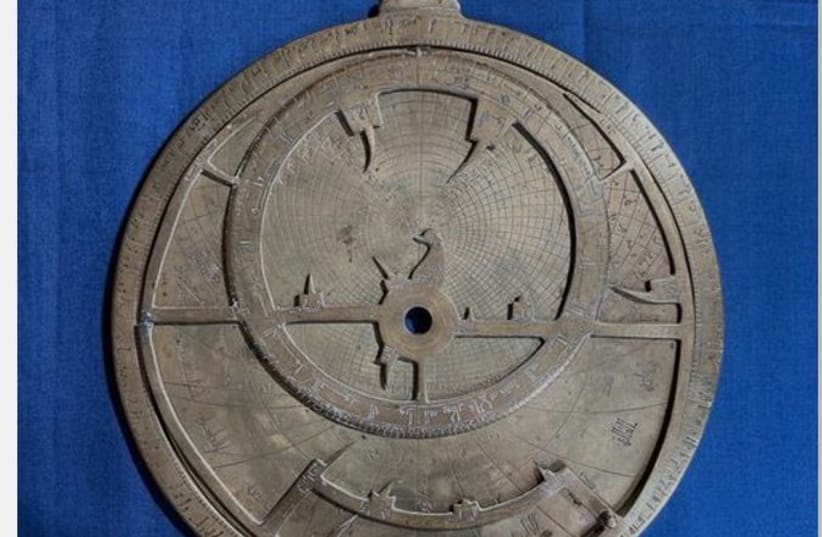Researchers at Cambridge University in the UK have discovered a rare astrolabe, an instrument that was the equivalent of the world’s first smartphone and portable computer that could be put to hundreds of uses. It was a portable, two-dimensional model of the universe that fit in the users’ hands, enabling them to calculate time and distances, plot the position of stars, and even forecast the future by casting a horoscope.
Dr. Federica Gigante of the history faculty of the university, which was founded in 1209 and became the fourth-oldest university in the world, made the discoveries in a museum in Verona and has just published them yesterday in the journal Nuncius under the title: “A Medieval Islamic astrolabe with Hebrew inscriptions in Verona: The seventeenth-century collection of Ludovico Moscardo.”
She first came across a newly uploaded image of the astrolabe by chance on the website of the Fondazione Museo Miniscalchi-Erizzo. Intrigued, she asked them about it. “The museum didn’t know what it was and thought it might be fake,” she recalled. “It’s now the single most important object in their collection.”
Twelfth-century Verona hosted one of the longest-standing and most important Jewish communities in Italy.
The astrolabe is thought to have made its way into the collection of the Veronese nobleman Ludovico Moscardo (1611–81) before passing by marriage to the Miniscalchi family. In 1990, the family founded the Fondazione Museo Miniscalchi-Erizzo to preserve the collections.


“This object is Islamic, Jewish, and European, [it] can’t be separated,” Gigante said.
Moscardo was born in 1611 into a noble family of Verona and early in his life, as he explained in the introduction to his catalogs, “not to be the same as the loafers of our age, I applied myself to an occupation that even if it wasn’t learned it was at least praiseworthy.”
In the space of his long life, he assembled a huge collection which he recorded in two separate catalogs, the first published in 1656 and the second, after the collection had much increased and came to include the astrolabes, in 1672.
Gigante pointed out that the translations reflect the recommendations prescribed by the Spanish-Jewish polymath Rabbi Abraham Ibn Ezra (1089-1167) in the earliest surviving treatise on the astrolabe in the Hebrew language written in 1146 in Verona – exactly where the astrolabe is found today.
Twelfth-century Verona hosted one of the longest-standing and most important Jewish communities in Italy. Ibn Ezra’s treatise assumes preexisting knowledge of the astrolabe among the Verona Jewish community, showing that the instrument must already have been popular.
His description has a lot in common with the Verona astrolabe that would have been in circulation by the time Ibn Ezra was in Verona. He warned his readers that an instrument must be checked before use to verify the accuracy of the values to be calculated.
Gigante suggested that the person who added the Hebrew inscriptions might have been following such recommendations.
“When I visited the museum and studied the astrolabe from up close, I noticed that not only was it covered in beautifully engraved Arabic inscriptions, but that I could see faint inscriptions in Hebrew. I could make them out only in the raking light entering from a window. I thought I might be dreaming but I kept seeing more and more. It was very exciting. This isn’t just an incredibly rare object – it’s a powerful record of scientific exchange among Arabs, Jews, and Christians over hundreds of years,” she added.
“The Verona astrolabe underwent many modifications, additions, and adaptations as it changed hands. At least three separate users felt the need to add translations and corrections to this object, two using Hebrew and one using a Western language.”
An expert on Islamic astrolabes and previously a curator of Islamic scientific instruments, Gigante dated and located the creation of the Verona astrolabe by analyzing its key construction and design attributes, and its main scientific and calligraphic characteristics.
The astrolabe had key design characteristics, native to Verona
She identified the object as Andalusian, and – from the style of the engraving and the arrangement of the scales on the back – matched it to instruments made in al-Andalus, the Muslim-ruled area of southern Spain, in the eleventh century.
One side of a plate is inscribed in Arabic “for the latitude of Cordoba, 38° 30’,” while the other side says “for the latitude of Toledo, 40°.” Gigante suggested that the astrolabe might have been made in Toledo at a time when it was a thriving center of coexistence and cultural exchange by Muslims, Jews, and Christians.
The astrolabe features Muslim prayer lines and prayer names that were arranged to ensure that its original intended users kept on time to perform their daily prayers.
The signature inscribed on the astrolabe reads, in Arabic, “for Ishāq [...]/the work of Yūnus.” This was engraved sometime after the astrolabe was made – probably for a later owner.
The two names, Ishāq and Yūnus – Isaac and Jonah in English – could be Jewish names written in the Arabic script, a detail that suggests that the object was at a certain point circulating within the Sephardi Jewish community in Spain where Arabic was the spoken language. A second added plate is inscribed with typical North African latitudes, suggesting that another point of the object’s life, it was perhaps used in Morocco or Egypt.
Hebrew inscriptions were added to the astrolabe by more than one person. One set of additions is carved deeply and neatly, while a different set of translations is very light, uneven, and shows an insecure hand.
“These Hebrew additions and translations suggest that at a certain point, the object left Spain or North Africa and circulated amongst the Jewish Diaspora community in Italy, where Arabic was not understood, and Hebrew was used instead,” Gigante speculated.
Unusually, one of the Hebrew additions, engraved neatly above the Arabic marking for latitude 35°, reads “34 and a half” rather than “34 ½,” which suggests that the engraver was not an astronomer or astrolabe maker.
Other Hebrew inscriptions are instead translations of the Arabic names for the astrological signs of Scorpio, Sagittarius, Capricorn, Aquarius, Pisces, and Aries.
Gigante believes later additions were made to the astrolabe's design
The astrolabe features corrections inscribed not only in Hebrew but also in Western numerals, the same we use in English today. All sides of the astrolabe’s plates feature lightly scratched markings in Western numerals, translating and correcting the latitude values, some even multiple times. Gigante believes that it was highly likely that these additions were made in Verona for a Latin or Italian language speaker.
In one case, someone lightly scratched the numbers “42” and “40” near the inscription reading “for the latitude of Medinaceli, 41° 30’”.
“Not only do both numerals differ from the value given in the Arabic, they don’t agree between themselves,” she continued. “It may be that a later user of the instrument thought the original Arabic value was wrong and amended it. But the correct, modern value for the latitude of Medinaceli is 41°15’, indicating that the Arabic value was more accurate than either amendment.” Elsewhere on the instrument, Gigante found similar conflicting and erroneous amendments relating to the latitudes of Cordoba and Toledo.
The astrolabe features a Rete – a pierced disk representing a map of the sky – which is one of the earliest known made in Spain. Remarkably, it features similarities with the Rete, the only surviving Byzantine astrolabe made in 1062 AD, as well as with those of the earliest European astrolabes made in Spain on the model of Islamic ones.
Gigante explained that “due to a phenomenon called the precession of the equinoxes, whereby the earth rotates on its axis not in a straight line but in a wobbly manner, like a spinning top about to stop, the stars’ apparent position above our heads changes constantly, about one degree every 70 years.” By analyzing the position of the stars on the Rete, it is possible to calculate that they were placed in the position that stars had been in during the late 11th century and that they match those of other astrolabes made, for example, in 1068 CE.
